The Latin phrase sanctum sanctorum is a translation of the Hebrew term קֹדֶשׁ הַקֳּדָשִׁים, literally meaning Holy of Holies, which generally refers in Latin texts to the holiest place of the Ancient Israelites, inside the Tabernacle and later inside the Temple in Jerusalem, but the term also has some derivative use in application to imitations of the Tabernacle in church architecture.
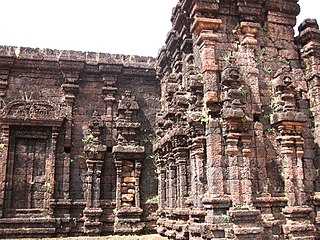
The Rajarajeswara temple is a Shiva temple located in Taliparamba in Kannur district of Kerala, India. The temple is regarded as one of the existing 108 ancient Shiva Temples of ancient Kerala. It also has a prominent place amongst the numerous Shiva temples in South India. It had the tallest shikhara amongst the temples of its time. The Rajarajeshwara temple has a top of about 90 tonnes. If any problem is encountered in the other temples of South India, devotees seek a solution in this temple through a prasnam, a traditional method of astrological decision making. The prasnam is conducted on a peedha outside the temple.

Somarama is one of the five Pancharama Kshetras that are sacred to the Hindu god Shiva. The temple is located in Bhimavaram of West Godavari district in the Indian state of Andhra Pradesh. It is one of the centrally protected monuments of national importance.

The Ranganthaswamy temple in Srirangapatna, in the Mandya district of Karnataka state, India, is dedicated to the Hindu god Ranganatha. It is one of the five important pilgrimage sites of Smartha -BaboorKamme & Sri Vaishnavism along the river Kaveri for devotees of Ranganatha. These five sacred sites are together known as Pancharanga Kshetrams in Southern India. Since Srirangapatna is the first temple starting from upstream, the deity is known as Adi Ranga. The town of Srirangapatna, which derives its name from the temple, is located on an island in the river Kaveri.

Jageshwar Temples, also referred to as Jageswar Temples or Jageshwar Valley Temples, are a group of 125 ancient Hindu temples dated between 7th and 14th century near Almora, in the Himalayan Indian state of Uttarakhand. The valley has a number of temple clusters such as the Dandeshwar and Jageshwar sites. Some locations have attracted construction of new temples through the 20th-century. Together these clusters over the valley consist of over 200 structural temples built from cut stone. Many are small, while a few are substantial. They predominantly illustrate North Indian Nagara style of architecture with a few exceptions that show South and Central Indian style designs, many are dedicated to god Shiva, while others in immediate vicinity are dedicated to god Vishnu, Shakti goddesses and Surya traditions of Hinduism.

Thiruvallur Veeraraghava Swamy Temple is a temple dedicated to the Hindu god Vishnu, located in Thiruvallur, Chennai Metropolitan City, an area and headquarters in Tiruvallur district in the South Indian state of Tamil Nadu. Constructed in Dravidian style of architecture, the temple is glorified in the Divya Prabandha, the early medieval Tamil canon of the Azhwar saints from the 6th–9th centuries CE. It is counted as one among the 108 Divya Desams dedicated to Vishnu. Vishnu is worshipped as Veeraraghava Perumal and his consort Lakshmi as Kanakavalli Thayar.

Sacred site, sacred ground, sacred space,holy ground, or holy place refers to a location which is deemed to be sacred or hallowed. The sacredness of a natural feature may accrue through tradition or be granted through a blessing. One or more religions may consider sacred locations to be of special significance. Often, such locations either are or become the home of sanctuaries, shrines, places of worship, or locations conducive to meditation. Regardless of construction or use, these areas may have a variety of ritual or taboo associations - including limitations on visitors or on allowed actions within the space. Such places may become the focus of pilgrimage, drawing pilgrims from great distances, or simply locations of significance for the local populace.

Nachiar Kovil or Thirunarayur Nambi Temple in Thirunarayur, a village in the outskirts of Kumbakonam in the South Indian state of Tamil Nadu, is dedicated to the Hindu god Vishnu and his wife Lakshmi. It is the sub urban region of business city of Kumbakonam.
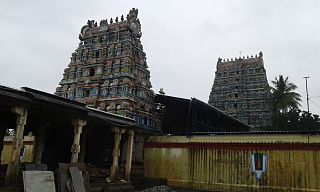
Thiruvali - Thirunagari Temples are paired Hindu temples dedicated to Lord Vishnu located 10 km away from Sirkali, Tamil Nadu, India and 5 km away from each other. It is one of the "Divya Desams", the 108 temples of Vishnu revered by the 12 poet saints, or Alwars. Unlike other Divyadesams where a single shrine is referred, this pair of temples is referred together in all the 41 paasurams(poems). These temples follow Thenkalai mode of worship.
Loganatha Perumal Temple is a Hindu temple dedicated to Vishnu located 2 km away from Sikkal, Tamil Nadu, India on the Tiruvarur-Nagapatnam highway. Constructed in the Dravidian style of architecture, the temple is glorified in the Divya Prabandha, the early medieval Tamil canon of the Azhwar saints from the 6th–9th centuries AD. It is one of the 108 Divyadesam dedicated to Vishnu, who is worshiped as Loganatha Perumal and his consort Lakshmi as Loganayagi.

Gajendra Varadha Perumal Temple in Thirukkavithalam, a village in the outskirts of Papanasam in the South Indian state of Tamil Nadu, is dedicated to the Hindu god Maha Vishnu. Constructed in the Dravidian style of architecture, the temple is glorified in the Divya Prabandha, the early medieval Tamil canon of the Azhwar saints from the 6th–9th centuries AD. It is one of the 108 Divyadesam dedicated to Vishnu, who is worshipped as Gajendra Varadha and his consort Lakshmi as Ramamanivalli. The temple is one of the five Pancha-Kannan temples, where Krishna, an avatar of Vishnu is given prominence over the presiding deity.

Neela Megha Perumal Temple or Sowriraja Perumal Temple is a Divyadesam temple in Thirukannapuram, a village in the outskirts of Nagapattinam in the South Indian state of Tamil Nadu, is dedicated to the Hindu god Vishnu. Constructed in the Dravidian style of architecture, the temple is glorified in the Divya Prabandha, the early medieval Tamil canon of the Azhwar saints from the 6th–9th centuries AD. It is one of the 108 Divyadesam dedicated to Vishnu, who is worshipped as Neelamegha Perumal and his consort Lakshmi as Thirukannapura Nayagi. As per Hindu legend, the presiding deity is believed to have appeared with a wig to save a devotee, leading to the name Sowriraja Perumal.

Thanjai Mamani Koil is a set of three Hindu temples dedicated to Lord Vishnu located in Thanjavur, Tamil Nadu, India and are close to each other. It is one of the Divya Desams, the 108 temples of Vishnu revered by the 12 poet saints, or Alwars. Unlike other Divyadesams where a single shrine is referred, this set of temples is referred together in all the paasurams (poems).
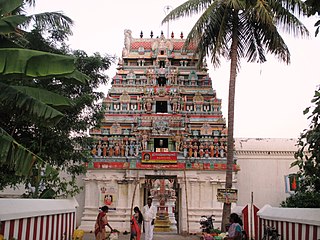
Nathan Kovil or Thiru Nandipura Vinnagaram Temple in Nathan Kovil, a village in the outskirts of Kumbakonam in the South Indian state of Tamil Nadu, is dedicated to the Hindu god Vishnu. Constructed in the Dravidian style of architecture, the temple is glorified in the Divya Prabandha, the early medieval Tamil canon of the Azhwar saints from the 6th–9th centuries AD. It is one of the 108 Divyadesam dedicated to Vishnu, who is worshipped as Jagannathan and his consort Lakshmi as Shenbagavalli.
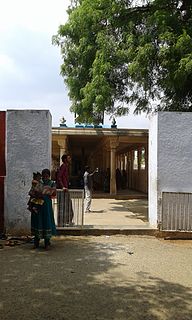
Irattai Tirupati Temple refers to two temples of the Nava Tirupathi, namely Devapiran temple and Aravindalochanar temple dedicated to Vishnu located in Tiruchendur-Tirunelveli route, Tamil Nadu, India in the banks of Thamiraparani river. All these 9 temples are classified as "Divya Desams", the 108 temples of Vishnu revered by the 12 poet saints Alwars. The two temples are located adjacent to each other. All these 9 temples of the Navatirupathi are also classified as "Divya Desams", the 108 temples of Vishnu revered by the 12 poet saints, or Alwars. The Irattai Tirupathi is also known Ketu Sthalam. Constructed in the Dravidian style of architecture, the temples are dedicated to Vishnu who is worshipped as Devapiran and Aravindalochanar and Lakshmi as Varagunavalli and Karuthadankanni.
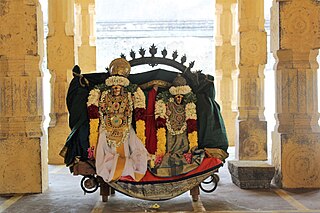
Uthsavar or Utsavar is derived from the Sanskrit word, Utsavam, a festival predominantly referring to Hindu religion. In Hinduism, it is referred to the festival deity's moorthi usually taken during temple festival processions. Utsavar moorthis are generally made of metal, and Moolavar murthi is usually made of stone. Ablution is performed on the Uthasavar images during daily prayer or during festivals. It is performed in a sequence with various material like milk, curd, honey and sugar. These are meant to indicate five elemental aspects of earth and with the ablution, prayers are sought to please the five natural elements.
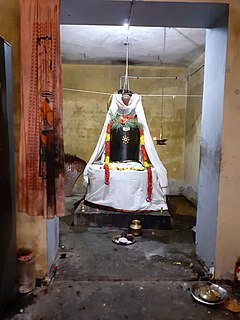
Moolavar or Mulavar is a Sanskrit, Tamil word referring to the main deity or murti in a Hindu Temple. Moola means "main" in Sanskrit, “Avar” means “He/She who is” honorific title in Tamil which in turn refers to the primary deity in the temple. The Moolavar image is permanently fixed in the sanctum. In Shiva temples, the Moolavar vigraha is usually Lingam, while in all other temples, the sculpted image of the respective deities are sported. The Moolavar is usually made of stone while in some temples, it is made of limestone or wood.

Pura Kehen is a Balinese Hindu temple located in Cempaga, Bangli Regency, Bali. The temple is set on the foot of a wooded hill, about 2 kilometres (1.2 mi) north of the town center. Established at least in the 13th-century, Pura Kehen was the royal temple of the Bangli Kingdom, now the Regency of Bangli.

Pura Goa Lawah is a Balinese Hindu temple or a pura located in Klungkung, Bali, Indonesia. Pura Goa Lawah is often included among the Sad Kahyangan Jagad, or the "six sanctuaries of the world", the six holiest places of worship on Bali. Pura Goa Lawah is noted for built around a cave opening which is inhabited by bats, hence its name, the Goa Lawah or "bat cave".
















